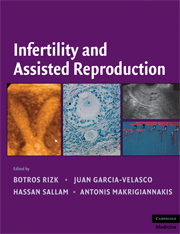Book contents
- Frontmatter
- Contents
- Contributors
- Foreword
- Preface
- Introduction
- PART I PHYSIOLOGY OF REPRODUCTION
- PART II INFERTILITY EVALUATION AND TREATMENT
- 6 Evaluation of the Infertile Female
- 7 Fertiloscopy
- 8 Microlaparoscopy
- 9 Pediatric and Adolescent Gynecologic Laparoscopy
- 10 Laparoscopic Tubal Anastomosis
- 11 Tubal Microsurgery versus Assisted Reproduction
- 12 The Future of Operative Laparoscopy for Infertility
- 13 Operative Hysteroscopy for Uterine Septum
- 14 Laser in Subfertility
- 15 Ultrasonography of the Endometrium for Infertility
- 16 Ultrasonography of the Cervix
- 17 Transrectal Ultrasonography in Male Infertility
- 18 The Basic Semen Analysis: Interpretation and Clinical Application
- 19 Evaluation of Sperm Damage: Beyond the WHO Criteria
- 20 Male Factor Infertility: State of the ART
- 21 Diagnosis and Treatment of Male Ejaculatory Dysfunction
- 22 Ovulation Induction
- 23 Clomiphene Citrate for Ovulation Induction
- 24 Aromatase Inhibitors for Assisted Reproduction
- 25 Pharmacodynamics and Pharmacokinetics of Gonadotrophins
- 26 The Future of Gonadotrophins: Is There Room for Improvement?
- 27 Ovarian Hyperstimulation Syndrome
- 28 Reducing the Risk of High-Order Multiple Pregnancy Due to Ovulation Induction
- 29 Hyperprolactinemia
- 30 Medical Management of Polycystic Ovary Syndrome
- 31 Surgical Management of Polycystic Ovary Syndrome
- 32 Endometriosis-Associated Infertility
- 33 Medical Management of Endometriosis
- 34 Reproductive Surgery for Endometriosis-Associated Infertility
- 35 Congenital Uterine Malformations and Reproduction
- 36 Unexplained Infertility
- 37 “Premature Ovarian Failure”: Characteristics, Diagnosis, and Management
- PART III ASSISTED REPRODUCTION
- PART IV ETHICAL DILEMMAS IN FERTILITY AND ASSISTED REPRODUCTION
- Index
- Plate section
- References
10 - Laparoscopic Tubal Anastomosis
from PART II - INFERTILITY EVALUATION AND TREATMENT
Published online by Cambridge University Press: 04 August 2010
- Frontmatter
- Contents
- Contributors
- Foreword
- Preface
- Introduction
- PART I PHYSIOLOGY OF REPRODUCTION
- PART II INFERTILITY EVALUATION AND TREATMENT
- 6 Evaluation of the Infertile Female
- 7 Fertiloscopy
- 8 Microlaparoscopy
- 9 Pediatric and Adolescent Gynecologic Laparoscopy
- 10 Laparoscopic Tubal Anastomosis
- 11 Tubal Microsurgery versus Assisted Reproduction
- 12 The Future of Operative Laparoscopy for Infertility
- 13 Operative Hysteroscopy for Uterine Septum
- 14 Laser in Subfertility
- 15 Ultrasonography of the Endometrium for Infertility
- 16 Ultrasonography of the Cervix
- 17 Transrectal Ultrasonography in Male Infertility
- 18 The Basic Semen Analysis: Interpretation and Clinical Application
- 19 Evaluation of Sperm Damage: Beyond the WHO Criteria
- 20 Male Factor Infertility: State of the ART
- 21 Diagnosis and Treatment of Male Ejaculatory Dysfunction
- 22 Ovulation Induction
- 23 Clomiphene Citrate for Ovulation Induction
- 24 Aromatase Inhibitors for Assisted Reproduction
- 25 Pharmacodynamics and Pharmacokinetics of Gonadotrophins
- 26 The Future of Gonadotrophins: Is There Room for Improvement?
- 27 Ovarian Hyperstimulation Syndrome
- 28 Reducing the Risk of High-Order Multiple Pregnancy Due to Ovulation Induction
- 29 Hyperprolactinemia
- 30 Medical Management of Polycystic Ovary Syndrome
- 31 Surgical Management of Polycystic Ovary Syndrome
- 32 Endometriosis-Associated Infertility
- 33 Medical Management of Endometriosis
- 34 Reproductive Surgery for Endometriosis-Associated Infertility
- 35 Congenital Uterine Malformations and Reproduction
- 36 Unexplained Infertility
- 37 “Premature Ovarian Failure”: Characteristics, Diagnosis, and Management
- PART III ASSISTED REPRODUCTION
- PART IV ETHICAL DILEMMAS IN FERTILITY AND ASSISTED REPRODUCTION
- Index
- Plate section
- References
Summary
INTRODUCTION
Bilateral tubal ligation as a form of permanent sterilization has been carried out in females for more than a century (1). Patients who have completed their desired family size and are certain about the lack of interest in future pregnancies find this procedure to be cost effective, relatively simple, and generally free of complications. Patients find this permanent procedure convenient since they do not have to deal with the costs and potential complications of different types of ongoing contraceptive methods, such as birth control pills and intrauterine contraceptive devices.
The procedure can be accomplished effectively by different routes, including vaginal or abdominal approaches, either through a mini-laparotomy or by laparoscopy. The timing of the procedure is variable as it can be performed right after a vaginal delivery or at the time of a cesarean section. Also, it can be accomplished in a gynecologic patient (interval tubal ligation) during the preovulatory phase of the menstrual cycle, commonly by laparoscopy. As for the methods used, the fallopian tubes can be sectioned and a segment of the tube removed, or if a laparoscopic approach is used, bipolar cauterization of the tubes or application of silastic rings or clips are popular alternatives (2–4).
It is estimated that as many as 700,000 procedures are performed each year in the United States, roughly half after delivery or at the time of a cesarean section and half by laparoscopic (interval) tubal ligation (5).
Keywords
- Type
- Chapter
- Information
- Infertility and Assisted Reproduction , pp. 91 - 98Publisher: Cambridge University PressPrint publication year: 2008
References
- 1
- Cited by



